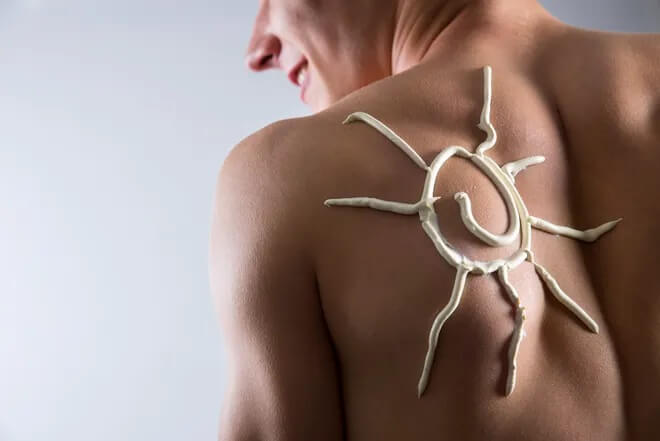Ready for Summer? Get Checked for Skin Cancer and Find the Right Sunscreen
Austinite Andrew Lee and his family had been temporarily working in New Zealand when the pandemic hit. Without access to his regular doctors, Lee waited until they returned to the United States two years later to see a dermatologist and get his regular skin check.
The Lees are all fair-skinned redheads. “We buy stock in sunscreen,” he jokes.
In April, during his dermatologist appointment, Lee didn’t expect Dr. Carmen Julian of U.S. Dermatology Partners to find anything. His wife and kids, who are 11 and 8, were fine, but he had a suspicious mole on his leg.
It had grown during the past year, was asymmetrical, and had a few different colors — all skin cancer warning signs.
“It’s on the side and not in an area I’m seeing all the time,” he said. “That’s why regular checkups are important.”
A biopsy revealed Lee had melanoma. Julian was able to remove all of it, but now Lee, 41, will need to go back every three months to get his skin checked for more skin cancers.
Most people without a history of skin cancer should see a doctor for a skin check every year. See a doctor sooner if you see a mole or patch of skin that has ABCDE issues:
- Asymmetrical — it should be uniform in size or shape across the mole.
- Borders — it should not be jagged or look moth-eaten; it should be smooth and round or oval.
- Color — it should be uniform, not getting darker or lighter or multicolored.
- Diameter — moles will grow with time, but they shouldn’t be growing rapidly, in a noticeable way.
- Evolution — changes have happened, or the skin is now itching or bleeding.
The American Academy of Dermatology offers these skin cancer facts:
- Skin cancer is the most common cancer in the United States.
- One in 5 people will get skin cancer in their lifetime.
- Skin cancer rates are higher in women than in men before age 50 but higher in men after age 50.
- The rates of basal cell carcinoma have increased 145% since the 1980s. The rates of squamous cell carcinoma have increased 243%. Melanoma rates have doubled.
- Basal cell and squamous cell carcinomas are very treatable, as is melanoma if it is caught before it has spread to the lymph nodes.
- If melanoma has spread to a nearby lymph node, the five-year survival rate is 68%. If it has spread to a lymph node farther away, the five-year survival rate is 30%.
- The risk of all skin cancers is higher in people who have skin that burns easily, have blond or red hair, have 50 or more moles, have a history of excessive skin exposure including sunburns in childhood or teenage years, or use a tanning bed.
- Men have a lower survival rate for melanoma than women.
- While non-Hispanic white people have higher rates of melanoma, people with darker skin tones are less likely to survive melanoma because it is often caught later.
Lee was lucky. His melanoma was caught early, before it become invasive and spread to lymph nodes.
Lee could check many of those risk-factor boxes: many moles, red-headed, skin that burns easily and several really bad sunburns as a child.
With his own children, he’s trying to make putting on sunscreen before they go outside a muscle memory, to be part of their routine, “so they will think of it, even if we don’t,” he said.
Julian had these tips to avoid skin cancer:
- Use something with sunscreen every day, even if you think you won’t be outside. Often, that can be in a moisturizer or makeup with an SPF number.
- Choose a sunscreen that is SPF 30 or higher.
- Reapply sunscreen all over at least every two hours that you are outside.
- Products that are lotions or creams work better than gels and sprays.
- Sunscreens with zinc or titanium dioxide, which are physical blockers, work better than those that are chemical blockers, though chemical blockers often feel nicer. Chemical blockers have ingredients such as aminobenzoic acid, avobenzone, octisalate, octocrylene and oxybenzone. Physical blockers create a barrier on the surface of the skin, but chemical blockers get into the skin and absorb the sun’s rays before the skin can do so.
- Use a thick layer of sunscreen, at least 1 ounce or the equivalent of a shot glass full.
- Don’t forget about the less obvious areas that have a high risk for skin cancer: lips, ears, the back of the neck, the back, backs of arms, backs of legs, feet and palms.
- Wear sun protective clothing that has UPF. A regular T-shirt has very little sun protection.
- Wear a wide-brim hat.
- On days when you’re outside often, seek the shade to give you a break from direct sunlight.
- Try to avoid being outside between 10 a.m. and 2 p.m., when the UV index is highest.
If you do get a sunburn, you can apply some soothing lotion to help moisturize the skin. Choose something bland like Aquaphor or petroleum jelly if the burn is bad.
For a second-degree burn — one with a blister — do not pop the blister. Have a cool bath or apply cool compresses on the burn itself. You can take ibuprofen to reduce the swelling and pain. Hydrocortisone cream also can help.
If the blister pops or the skin beneath it appears wet, see a doctor to rule out infection.
Read Full Article Here






